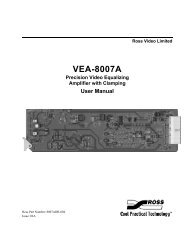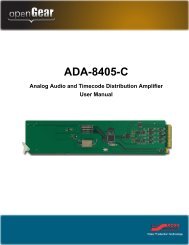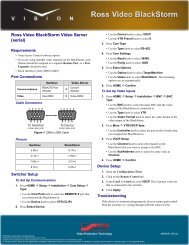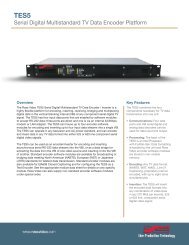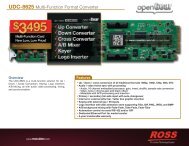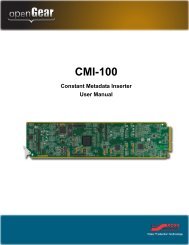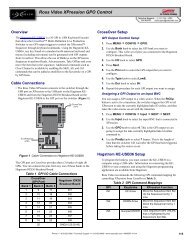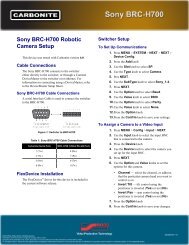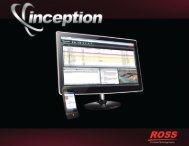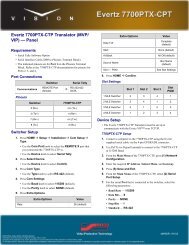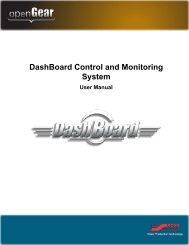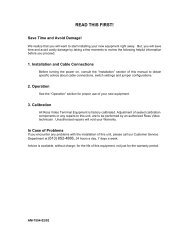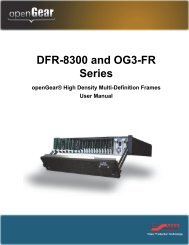CDK-111A-Lite Owner's Guide - Ross Video
CDK-111A-Lite Owner's Guide - Ross Video
CDK-111A-Lite Owner's Guide - Ross Video
- No tags were found...
Create successful ePaper yourself
Turn your PDF publications into a flip-book with our unique Google optimized e-Paper software.
The components of the serial data are shown in the figure below. These are:1. The break character, to prepare the serial interface for communication.2. An address byte, to select the keyer as the device to communicate withthe editor. For the <strong>CDK</strong>-<strong>111A</strong>-<strong>Lite</strong>, this is factory shipped as 30H(Hex) with the ability to change it to any legal value.3. The command / message blocks,which actually direct keyer operation.The structure of these blocks is discussed in the next sections.BREAKADDRESSBYTESelectAddressorPollAddressCommand/Message BlocksProtocol ElementsBreak Character (00)The break character is sent by the editor to the serial port of the keyer to prepare itfor receipt of further data. The break character puts the editor interface into the“active” state. After receipt of the break character, the keyer ceases all buscommunications, resets any communication errors, empties the receive buffer of allpending commands, and awaits receipt of an address byte. The break character iscomposed of 17 to 20 bits of spacing data (low logic level) followed by a minimumof two bits of marking data (high logic level).Address Byte (Editor Select Address)Following receipt of the break character, the editor interface will expect a one-byteaddress, either the Select Address or the Poll Address. Most often, the address sent isthe Select Address. The editor select address identifies the keyer as the device tocommunicate with the editor.The Select Address must always be an even number. The Poll Address equals theSelect Address plus “1”, and is sent by the editor to determine if the keyer is on thebus. If the keyer is present (active), it sends an “acknowledge byte” of 84H (Hex)back to the editor and remains in the active state. The keyer is now ready to acceptcontinuous command/message transmission from the editor without going throughthe initial break/address sequence again. Any communication errors or “time outs”cause the keyer to send a “negative acknowledge byte” of 85H, reject anyunexecuted commands, and return to the idle state.Receipt of any other device’s Select Address also causes the serial interface to enterthe idle state, requiring the break/address sequence to be performed before thecommunication can be restored. If another device’s Poll Address is received, it isignored and the serial interface remains in the active state.The Select Address is set on the <strong>CDK</strong>-<strong>111A</strong>-<strong>Lite</strong> via the rotary Board ID dial at thecard edge. The select address for the keyer is the indicated Board ID on the dialmultiplied by 2. If zero is selected, the Select Address is determined by navigating tothe on-screen menu system. The on-screen menu system allows the selection of anylegal select address (00-FC, even numbers).<strong>CDK</strong>-<strong>111A</strong>-<strong>Lite</strong> • Owner’s <strong>Guide</strong> v4B Appendix A. Serial Protocols • 4-5



